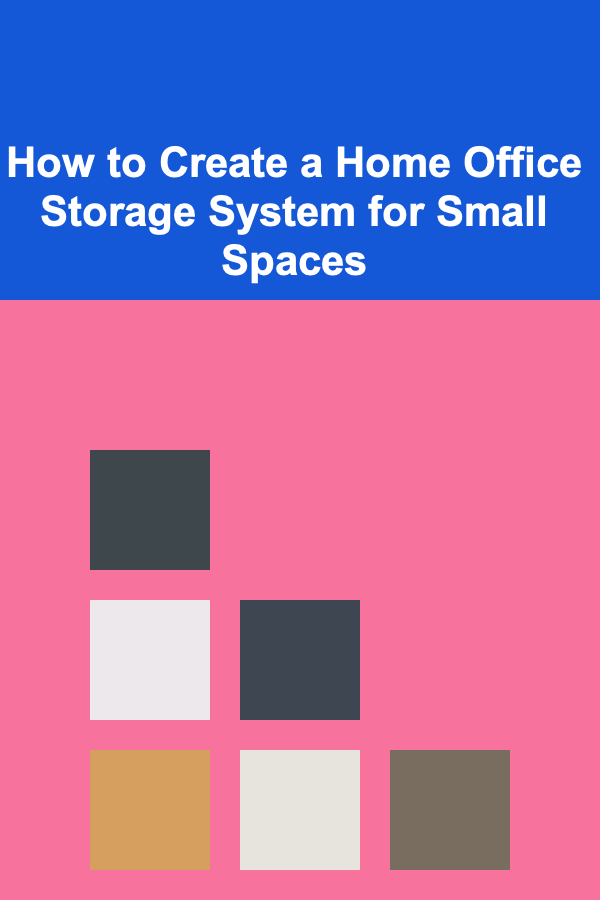
How to Create a Home Office Storage System for Small Spaces
ebook include PDF & Audio bundle (Micro Guide)
$12.99$8.99
Limited Time Offer! Order within the next:

In the modern era, working from home has become a popular choice for many professionals, freelancers, and entrepreneurs. While working remotely offers flexibility and comfort, it also comes with its own set of challenges, particularly in terms of creating an effective home office environment. One of the most common challenges is managing the limited space available. Small spaces can feel cramped and cluttered, making it difficult to stay organized and productive.
Creating a home office storage system for small spaces is an essential task to make the most of every inch available. The key to an efficient home office lies in using smart design and storage solutions that keep your workspace tidy, organized, and functional. In this article, we will explore a variety of methods and strategies to build a highly functional storage system that maximizes small spaces without compromising on aesthetics or usability.
The Importance of Organization in a Small Home Office
When you work in a small space, organization becomes crucial. Not only does a cluttered workspace negatively impact productivity, but it can also lead to unnecessary stress and frustration. An organized home office helps reduce distractions, creates a more professional environment, and enables you to focus on your tasks without wasting time searching for items.
In a small home office, every item must have a designated place. The organization is not just about keeping things tidy --- it's about ensuring that everything has easy access, while also optimizing the limited space you have. A well-organized home office can drastically improve your workflow and make the most out of even the smallest of rooms.
Understanding the Space You Have
Before you begin building a storage system for your home office, it's important to understand your space. Take note of the following elements:
1. Available Wall Space
Often, in a small home office, the walls provide the most valuable real estate for storage. Utilizing vertical space can make a world of difference in terms of how much storage you can fit into a small area. Look at your walls as a canvas for installing shelves, cabinets, and hanging organizers.
2. Room Layout and Traffic Flow
Consider how you move through the space. There should be enough room to sit comfortably at your desk, access your equipment, and move freely. Avoid overcrowding the room with too many storage solutions that block essential pathways or hinder movement.
3. Furniture Constraints
In small spaces, furniture needs to be functional and multi-purpose. Your desk should be large enough to accommodate your computer and paperwork, but it shouldn't overwhelm the room. Consider space-saving furniture pieces such as wall-mounted desks or foldable tables, which can be tucked away when not in use.
By understanding these elements, you can design a storage system that fits seamlessly into your existing space while optimizing every available square foot.
Key Principles for Designing Storage Systems for Small Spaces
1. Maximize Vertical Space
In small spaces, the floor area is limited, but the vertical space is often underutilized. This is where shelves and wall-mounted storage systems can come into play. By using wall-mounted shelving, pegboards, floating desks, and hanging organizers, you can store a significant amount of office supplies without cluttering up the floor.
- Wall-Mounted Shelves: Installing shelves above your desk or along unused wall spaces helps free up valuable desk surface area. You can store books, office supplies, and decorative items without taking up any additional floor space.
- Pegboards: Pegboards are a versatile and customizable solution for organizing items like pens, scissors, cables, and folders. They allow you to arrange your items in a way that is both visually appealing and functional.
- Floating Desks: A floating desk mounted on the wall provides the essential workspace without taking up too much space. It's especially useful in small rooms where floor space is limited.
- Overhead Cabinets: Cabinets mounted above the desk can be used to store less frequently used items or office supplies. By placing them higher up, you avoid crowding the desk area.
2. Use Multifunctional Furniture
When dealing with a small home office, furniture pieces that serve multiple purposes are essential. Multifunctional furniture can save space and reduce the need for additional storage pieces.
- Desk with Built-in Storage: Some desks come with built-in drawers or shelves underneath, which can be used to store office supplies, paperwork, or tech gadgets. This helps keep the desk surface clear and organized.
- Filing Cabinets: A filing cabinet can be used not only for filing documents but also for general office storage. Choose a smaller, vertical filing cabinet that fits under or next to the desk.
- Storage Ottomans or Chairs: Furniture pieces like ottomans with hidden storage or chairs with built-in drawers can double as both seating and storage, making them great for smaller rooms.
- Convertible Furniture: Consider a desk that can fold down into a compact wall unit when not in use. There are also desks that transform into standing desks, which are a great choice for individuals who want to alternate between sitting and standing.
3. Declutter Regularly
A key part of organizing a small office is preventing clutter from building up in the first place. In smaller spaces, even a small amount of disorganization can make the room feel chaotic and unproductive. Establish a routine for decluttering:
- File Documents: Instead of leaving papers and documents on your desk, file them regularly. Use filing cabinets, drawer organizers, or inbox trays to store important documents out of sight but within easy reach.
- Digital Organization: A large part of home office storage also involves digital files. Organize your computer files into folders, create a digital filing system, and consider using cloud storage to back up important files.
- Daily Cleanup: Set aside 5-10 minutes at the end of each day to tidy up your office space. This ensures that your workspace is clear when you start work the next day.
4. Store Items by Frequency of Use
In a small home office, it's important to prioritize accessibility. Items that you use regularly should be easy to reach, while items that are used less often can be stored in less accessible places.
- Frequent Use Items: Place essential items such as your computer, phone, notebook, and pens on your desk or in desk drawers. These items should be organized in a way that allows for easy access without cluttering your workspace.
- Infrequent Use Items: Store items that you don't use daily, such as extra paper, backup devices, or reference materials, in cabinets, drawers, or storage bins. These can be placed higher up or in harder-to-reach locations.
5. Embrace Minimalism
A minimalist approach to your home office design and storage system can help prevent your workspace from feeling overcrowded. Minimalism focuses on keeping only the essentials and getting rid of anything that isn't necessary.
- Declutter Decor: Keep decorative items to a minimum. While it's nice to have a few personal touches, a small office can quickly feel cluttered if it's filled with too many items. Choose a few meaningful pieces that inspire productivity, such as artwork or plants.
- Simple Storage Solutions: Choose storage solutions that blend into the background rather than dominating the space. Opt for neutral colors and sleek designs for furniture and storage units to keep the office feeling open and airy.
6. Use Storage Bins and Containers
Storage bins and containers are your best friends when organizing small office spaces. These items can be used to group similar office supplies together and keep your workspace organized without taking up valuable space.
- Drawer Organizers: For desk drawers, use organizers to separate different items such as pens, paperclips, and notepads. This prevents these items from getting mixed up and creates a more efficient workspace.
- Storage Bins: Use bins to store extra supplies, books, or paperwork. Label each bin for easy identification. Store bins on high shelves or under the desk to keep the office tidy.
- Cable Management: Cables and cords can easily create a tangled mess in a small space. Use cable organizers, clips, and ties to keep your wires neat and out of sight.
Customizing Your Home Office Storage System
While these principles are universally effective, every home office is unique. Depending on your needs and preferences, you may want to further customize your storage system. Here are a few ideas to personalize your office storage:
- Create a Personalized Filing System: For people who work with a lot of physical paperwork, creating a personalized filing system that matches your workflow is essential. Use color-coded folders or labeled file boxes to easily access important documents.
- Add Vertical Gardens: A vertical plant rack or hanging pots can provide a green touch to your office while freeing up valuable desk space. Plants also improve air quality and create a more inviting work environment.
- Designate a Craft or Creative Corner: If you're a designer or craftsperson, consider carving out a small corner for creative supplies. Use drawers, baskets, or open shelving to store tools and materials.
- Portable Storage: For people who need to move between workstations or different areas of the home, portable storage units like rolling carts or storage trunks can provide flexibility and mobility.
Conclusion
Creating a home office storage system for small spaces is a challenge, but it is also an opportunity to design a workspace that is both functional and aesthetically pleasing. By maximizing vertical space, using multifunctional furniture, and regularly decluttering, you can transform even the smallest room into a highly efficient and organized home office.
Remember that the key to a successful small home office is not just about fitting in as many items as possible but about creating a space that works for you. Personalize your storage system to match your workflow, and prioritize organization to make the most of your space. With careful planning, creativity, and a little DIY effort, you can build a home office that promotes productivity, reduces stress, and maximizes your limited space.
Reading More From Our Other Websites
- [Beachcombing Tip 101] Best Sustainable Packing List for Multi‑Day Beachcombing Trips in Remote Archipelagos
- [Home Budget 101] How to Create a Debt-Free Home Budget
- [Home Soundproofing 101] How to Use Foam Insulation to Soundproof Your Home
- [Personal Investment 101] How to Invest in Precious Metals as a Hedge Against Inflation
- [Beachcombing Tip 101] Marine Marvels: Rare Creatures and Materials That Make the Sea a Treasure Trove
- [Personal Care Tips 101] How to Choose a Deodorant That Is Travel-Friendly and Compact
- [Personal Care Tips 101] How to Choose Acne Treatment Creams That Won't Interfere with Makeup
- [Home Holiday Decoration 101] How to Master the Art of Holiday Decorating with Cinnamon Sticks: A Complete Guide
- [Home Space Saving 101] How to Organize Small Living Spaces for Maximum Functionality
- [Home Staging 101] How to Choose a Home Stager That Specializes in Luxury Properties: A Guide

How to Design a Home Office That Inspires Creativity
Read More
How to Improve Home Security with Motion-Sensor Lights
Read More
How to Make a Fun Family Tradition out of Photo Albums
Read More
How to Use Under-Bed Storage to Declutter Your Bedroom
Read More
10 Tips for Negotiating Consignment Agreements
Read More
10 Tips for Tie Dyeing Pet Accessories
Read MoreOther Products

How to Design a Home Office That Inspires Creativity
Read More
How to Improve Home Security with Motion-Sensor Lights
Read More
How to Make a Fun Family Tradition out of Photo Albums
Read More
How to Use Under-Bed Storage to Declutter Your Bedroom
Read More
10 Tips for Negotiating Consignment Agreements
Read More